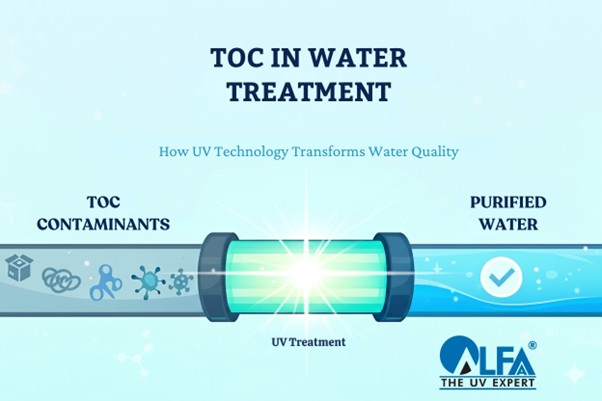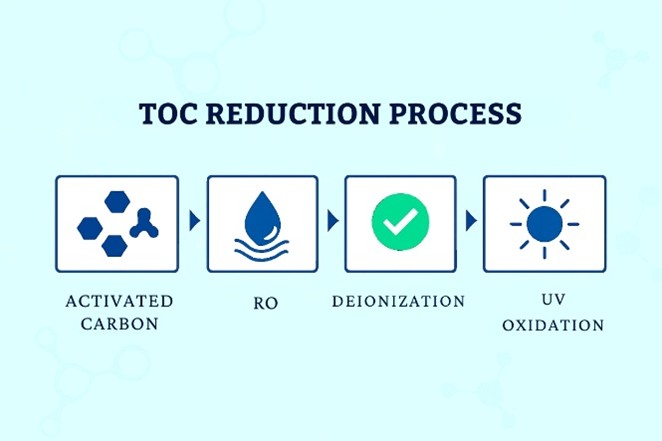
When we think about water quality, minerals, hardness, or microbial contamination usually come to mind. But in industries that demand ultra-pure water, there’s another critical parameter: TOC – Total Organic Carbon.
In this blog, we’ll explore:
What is TOC in Water?
TOC (Total Organic Carbon) is the measure of organic carbon compounds in water. These compounds may come from:
Even when water looks crystal clear, it may still contain trace levels of TOC – and for certain industries, those traces matter a lot.
Why TOC Matters in Industries
Not every sector worries about TOC. It’s mainly pharma and microelectronics where TOC can make or break operations.
In pharma, controlling TOC isn’t optional – it’s mandatory.
For semiconductor fabs, TOC is a precision and profitability issue. Ultra-pure water standards for microelectronics.
How is TOC Reduced in Water Treatment?
Reducing TOC requires multiple steps, depending on the purity level required:

Important: UV works best as a final polishing step once water is already clarified, because UV light requires low turbidity to penetrate effectively.
The Role of UV in TOC Reduction
At 185 nm wavelength, UV light goes beyond disinfection – it actually oxidizes organic molecules, reducing TOC.
This makes UV systems indispensable for final-stage TOC polishing.
Alfaa UV’s TOC Reduction Solutions
At Alfaa UV, we design solutions for industries where TOC control isn’t just about water – it’s about compliance, precision, and protecting your high-value processes.
Our WWR Series UV systems deliver:
Learn more about Alfaa UV’s TOC Reduction Applications
Explore our WWR Series UV Systems for ultra-pure water
TOC in Action: Pharma & Microelectronics
In both cases, TOC is more than a number – it’s a critical quality factor.
TOC in water treatment may not matter in everyday applications, but in pharma and microelectronics, it’s non-negotiable.
By combining RO, AOP, and UV polishing, industries can achieve consistently low TOC levels. And with partners like Alfaa UV, TOC reduction becomes not just possible, but reliable.
Because in high-stakes industries, there’s no room for compromise on water quality.
FAQs on TOC in Water Treatment
Q1. What does TOC mean in water treatment?
TOC stands for Total Organic Carbon, a measure of organic contaminants in water. It’s especially important in ultra-pure water applications like pharma and semiconductors.
Q2. Why is TOC important in pharmaceuticals?
Pharma regulations (USP <643>, EP 2.2.44) set strict TOC limits. High TOC can support microbial growth and compromise drug safety.
Q3. How does TOC affect microelectronics?
In semiconductor fabs, even trace TOC can leave residues on wafers, causing defects and reducing chip yield.
Q4. Can UV help reduce TOC in water?
Yes. At 185 nm wavelength, UV oxidizes organic molecules, lowering TOC. It works best as a final polishing step after other treatment processes.
Q5. What are common methods to reduce TOC?
Activated carbon, RO, deionization, advanced oxidation processes, and UV treatment are commonly used together for TOC reduction.
Ultraviolet UV water purification systems for drinking water disinfection...Read More
Ultraviolet UV water purification systems for process Water Disinfection...Read More
Ultraviolet UV water purification systems for waster water tertiary treatment...Read More
Ultraviolet UV water purification systems for Swimming pool and spas...Read More

Ultraviolet UV water purification systems for the Reduction of Total Oxidizable Carbons ( TOC )...Read More

Ultraviolet UV water purification systems for Ozone destruction...Read More

Ultravoilet UV air purification systems for...Read More
When it comes to choosing a water disinfection system for yo... Read More
Hidden Germs Live on Surfaces for Days. Eliminate Them in Mi... Read More
Being a limited resource, the importance of water conservati... Read More
UV Disinfection Systems for Water Treatment: How They Work a... Read More
Effective wastewater treatment is crucial for environmental ... Read More
At Alfaa UV, we understand that choosing the right water pur... Read More
Are you looking for a streamlined, space-saving solution to ... Read More
When you think of the food and beverage industry, water migh... Read More